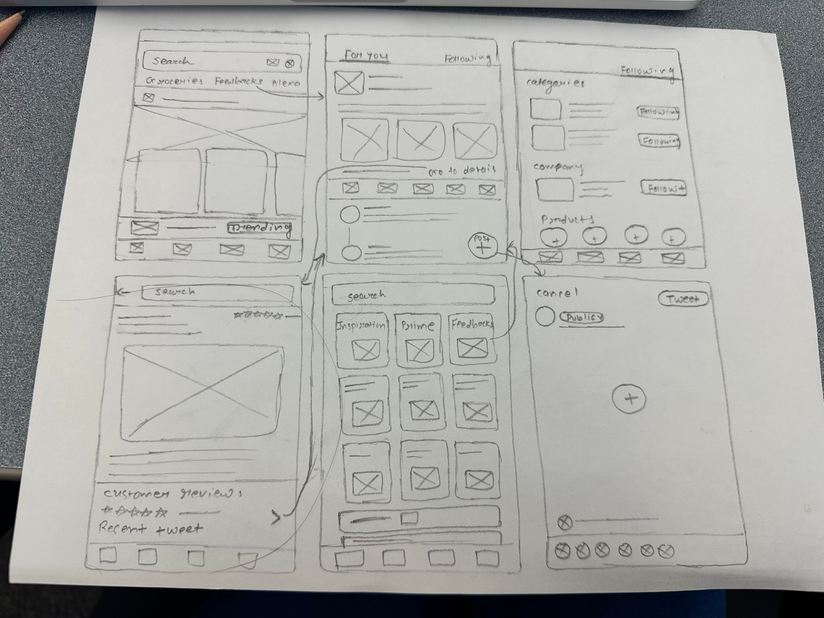Share thoughts, discover trends, and connect with a vibrant community—all in one app!


TWEETSHOP APPLICATION DESIGN
Background
The 'TweetShop Application' emerges as a new path, reshaping the traditional online shopping experience. This case study delves into the fusion of Twitter-like features with the Amazon app, offering users a revolutionary way to share, review, and connect. Creating a unique synergy between social interaction and core business enhancement.
Role
UX / UI designer
Pen, Paper, Figma, FigJam, Canva
Tools
Solo Project
Team
-
Users accustomed to the traditional Amazon experience might find it challenging to adjust to the newly integrated social features, impacting overall satisfaction.
-
Striking the right balance between social interaction and the core shopping experience poses a challenge, ensuring users stay focused and avoid distractions.
-
The introduction of a social feed could potentially overwhelm users with information, complicating the process of finding products.
What Challenges could be
I conducted user interviews and prepared user questionnaire to illuminate crucial insights into user preferences and expectations. These findings, derived from the questionnaire results and user feedback, serve as pivotal guideposts in identifying areas for improvement and innovation within the integration process.
An overwhelming 80% of users expressed a desire for a more socially enriched shopping journey.
Over 75% of participants highlighted the significance of direct communication to get to know about other user's experience from their purchasing.
Users want easy access to real-time product information and reviews from other users, allowing them to make more informed buying decisions.
Users showcased a keen interest in real-time information and engagement, aligning seamlessly with the goal of enhancing user engagement.




Understanding the problem - what will our End-users need?
From these findings, I decided:
-
Establish a seamless and cohesive user experience by creating a unified feed for sharing thoughts, recommendations, and engaging with others' posts.
-
Facilitate meaningful discussions and reviews related to specific products through the implementation of product tweets.
-
Foster a sense of community within the app by implementing a follow system, allowing users to connect and interact with each other.
-
Enhance user engagement by introducing trending topics and hashtags related to products, encouraging users to discover and participate in popular discussions.
Vision and Solution
To understand its positioning and potential, a comprehensive competitive analysis was conducted, focusing on similar products and established social media platforms like Instagram, TikTok, and Twitter.
Analyzed similar platforms



TikTok has revolutionized short-form video content and influencer marketing, presenting an opportunity for brands to showcase products through engaging video clips.
TikTok
It was obvious to explore twitter for this problem. Twitter, known for its conversational nature and real-time updates, shares similarities with the TweetShop Application in terms of fostering discussions and sharing user-generated content.
Instagram has successfully integrated shopping features into its interface, allowing users to discover products through curated feeds and sponsored posts and this is one of the leading social media platforms in competition of Twitter
Imagining the perfect outcome for this project, what would it do for customers, for businesses, for Amazon?
Users would seamlessly explore and purchase products, interact with others, and share feedback within their network. They'd benefit from a diverse array of product reviews and tweets, empowering them to make informed decisions when shopping.
The Twitter-like feature might disappoint users if it doesn't meet expectations or add significant value to Amazon. If it's too confusing or similar to Twitter, users may feel frustrated or prefer to stick with the original platform.
Imagining this project was a total failure - what could go wrong? Why would customers hate it, why would Amazon remove this feature?
In information architecture, I am organizing and structuring information in a way that is easy for users to understand and navigate. This involves creating a hierarchy of information, categorizing content, and creating a system of navigation to help users find what they are looking for.
Information Architecture

Sketches
By crafting detailed wireframes, I visualized the user journey, allowing for a comprehensive understanding of how users would interact with the product. This crucial step laid the foundation for the subsequent design phases, ensuring a user-centric approach and seamless navigation throughout the application.
Wire Flow

In the high-fidelity designs phase for TweetShop, I transformed conceptual wireframes into visually compelling interfaces. This stage not only focused on aesthetics but also prioritized a user-centric approach.
Results




Unified feed for sharing thoughts, recommendations, and engaging with others' posts.








Discussions and reviews related to specific products through the product tweets.
Follow option to connect with others
Chat system to allow users to connect and interact with each other
Trending products on Tweet and hashtags related to products, encouraging users to discover and participate in popular discussions.
-
Users explored TweetShop, engaging in activities like browsing the feed, go through the tweets for a particular product and participating in chats.
-
Tasks aimed to observe user interaction with social features during shopping.
Tasks
Usability Testing
After creating Prototype and High Fidelity, I conducted 5 Interviews. I asked 5 different participants to run through different tasks in my Prototype. I got enough of feedbacks to improve my design.
-
Valuable insights from usability testing.
-
Participants provided feedback on interface, communication, and overall user experience.
-
User-centric feedback guided specific areas for improvement.
Feedback
-
Iterative adjustments based on feedback resulted in a TweetShop aligned with user preferences.
-
Enhancements focused on interface intuitiveness and communication features to meet diverse user needs.
Outcome
Clickable Prototype
-
Balancing Social and Shopping Experience:
I leaned integrating social features into an e-commerce platform requires striking the right balance between social interaction and core shopping functionalities. Ensuring that social features enhance, rather than distract from, the shopping experience is essential.
-
Engagement and Community Building:
Implementing features such as unified feeds, discussions, product tweets, and chat systems fosters user engagement and community building within the app. Encouraging users to participate in discussions and share their experiences enhances the overall user experience.
Learnings
Next Case Study











